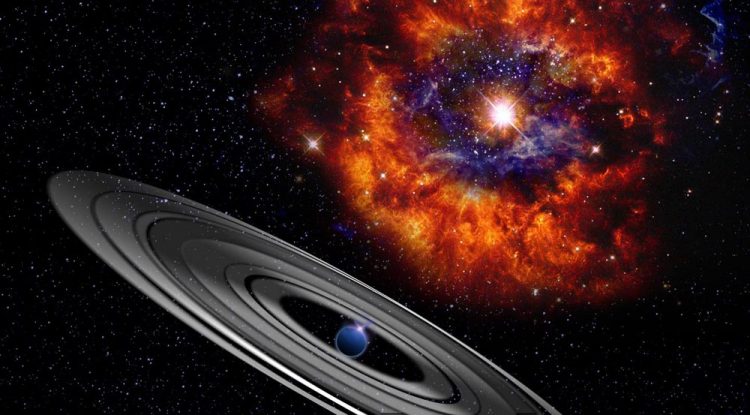Giant ringed planet likely cause of mysterious eclipses

This is an artist's impression of the giant gas planet orbiting the star PDS 110. Credit: University of Warwick
- A giant gas planet – up to 50x the mass of Jupiter, encircled by a ring of dust – is likely hurtling around a star over 1000 light years away from Earth, according to international team of astronomers, led by University of Warwick
- Light from young star – PDS 110 in the Orion constellation – is regularly blocked by large object, thought to be an orbiting planet
- Next eclipse predicted to take place in September this year, and amateur astronomers across the world will be able to witness it
- Moons may be forming in the habitable zone around the star – leading to possibility that life could thrive within system
A giant gas planet – up to fifty times the mass of Jupiter, encircled by a ring of dust – is likely hurtling around a star more than a thousand light years away from Earth, according to new research by an international team of astronomers, led by the University of Warwick.
Hugh Osborn, a researcher from Warwick's Astrophysics Group, has identified that the light from this rare young star is regularly blocked by a large object – and predicts that these eclipses are caused by the orbit of this as-yet undiscovered planet.
Using data from the Wide Angle Search for Planets (WASP) and Kilodegree Extremely Little Telescope (KELT), Osborn and fellow researchers from Harvard University, Vanderbilt University, and Leiden Observatory analysed fifteen years of the star's activity.
“We found a hint that this was an interesting object in data from the WASP survey,” said Hugh Osborn, lead author, who discovered the unusual light curve, “but it wasn't until we found a second, almost identical eclipse in the KELT survey data that we knew we had something special.”
They discovered that every two and a half years, the light from this distant star – PDS 110 in the Orion constellation, which is same temperature and slightly larger than our sun – is reduced to thirty percent for about two to three weeks. Two notable eclipses observed were in November 2008 and January 2011.
“What's exciting is that during both eclipses we see the light from the star change rapidly, and that suggests that there are rings in the eclipsing object, but these rings are many times larger than the rings around Saturn,” says Leiden astronomer Matthew Kenworthy.
Assuming the dips in starlight are coming from an orbiting planet, the next eclipse is predicted to take place in September this year – and the star is bright enough that amateur astronomers all over the world will be able to witness it and gather new data. Only then will we be certain what is causing the mysterious eclipses.
If confirmed in September, PDS 110 will be the first giant ring system that has a known orbital period.
“September's eclipse will let us study the intricate structure around PDS 110 in detail for the first time, and hopefully prove that what we are seeing is a giant exoplanet and its moons in the process of formation,” comments Hugh Oborn.
The researchers suggest that there are moons could be forming in the habitable zone around PDS 110 – pointing to the possibility that life could thrive in this system.
The eclipses can also be used to discover the conditions for forming planets and their moons at an early time in the life of a star, providing a unique insight into forming processes that happened in our solar system.
###
The research, 'Periodic Eclipses of the Young Star PDS 110 Discovered with WASP and KELT Photometry', is due to be published in the Monthly Notices of the Royal Astronomical Society.
Media Contact
All latest news from the category: Physics and Astronomy
This area deals with the fundamental laws and building blocks of nature and how they interact, the properties and the behavior of matter, and research into space and time and their structures.
innovations-report provides in-depth reports and articles on subjects such as astrophysics, laser technologies, nuclear, quantum, particle and solid-state physics, nanotechnologies, planetary research and findings (Mars, Venus) and developments related to the Hubble Telescope.
Newest articles

Superradiant atoms could push the boundaries of how precisely time can be measured
Superradiant atoms can help us measure time more precisely than ever. In a new study, researchers from the University of Copenhagen present a new method for measuring the time interval,…

Ion thermoelectric conversion devices for near room temperature
The electrode sheet of the thermoelectric device consists of ionic hydrogel, which is sandwiched between the electrodes to form, and the Prussian blue on the electrode undergoes a redox reaction…

Zap Energy achieves 37-million-degree temperatures in a compact device
New publication reports record electron temperatures for a small-scale, sheared-flow-stabilized Z-pinch fusion device. In the nine decades since humans first produced fusion reactions, only a few fusion technologies have demonstrated…





















